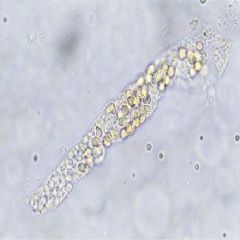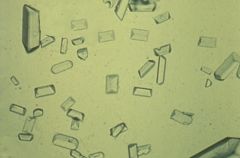![]()
![]()
![]()
Use LEFT and RIGHT arrow keys to navigate between flashcards;
Use UP and DOWN arrow keys to flip the card;
H to show hint;
A reads text to speech;
20 Cards in this Set
- Front
- Back
|
_____ mL of urine is needed for centrifugation for urine sedimentation.
|
6 mL
|
|
|
The ideal method of urine collection is ________?
|
Cystocentesis
|
|
|
What can be seen when examining the urine sediment on low power?
|
Casts and Epithelial cells
|
|

Identify the element pictured
|
Red Blood Cell Cast
|
|

Identify the primary element pictured
|
Struvite Crystals or Triple Phosphate Crystals
|
|
|
Monohydrate Calcium Oxalate Crystals are typically associated with what toxicity
|
Ethylene Glycol
|
|
|
A cell that is large and flat, has angular sides and small nuclei. Cell also originates from the distal 1/3 of the urethra, prepuce, and vagina. Large flat cell with angular sides and small nuclei that originates from the distal 1/3 of the urethra, vagina, or prepuce.
|
Squamous Epithelium
|
|
|
Explain how casts are formed in the kidneys.
|
Casts are formed in the renal tubules. This is where the secreted protein precipitates due to greater acidity of the urine in the tubules.
|
|
|
Which cast indicates chronic, severe, degeneration of the renal tubules?
|
Waxy Casts
|
|
|
What artifacts other than casts, crystals, or red or white blood cells be found when examining urine sediment under the microscope?
|
Mucus threads, spermatozoa, fat droplets, hair, other misc. artifacts
|
|
|
White blood cell casts are indicative of __________.
|
Pylonephritis
|
|
|
Which cast that when seen in low numbers is considered normal?
|
Hyaline Casts
|
|
|
Casts that are formed in the renal tubules usually take what shape?
|
The form of the tubule the cast was formed in.
|
|
|
Renal epithelial cells originate from
|
the renal tubules.
|
|
|
What type of crystals may be seen with renal tubular dysfunction?
|
Cystine Crystals
|
|
|
Epithelial cells that originate from the renal pelvis, bladder, proximal urethra or ureters are
|
Transititional epithelial cells
|
|

This crystal may be present in urine with portacaval shunts.
|
Ammonium Biurate
|
|
|
What are the two urine stains that are used when staining urine sediment?
|
SediStain and or New-Methylene Blue
|
|
|
When centrifuging urine for microscopic examination, how long should the urine be spun at what speed?
|
3 - 6 minutes at 1,000 - 2,000 rpm
|
|
|
What time of the day is best for collecting urine?
|
First urine in the morning.
|

